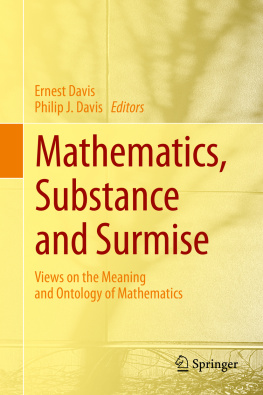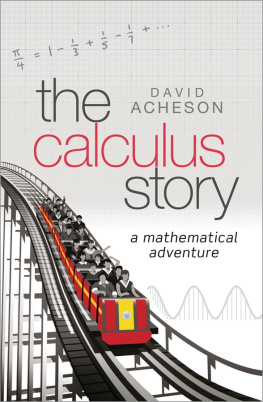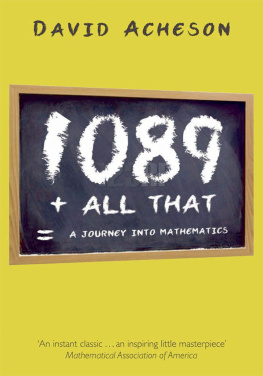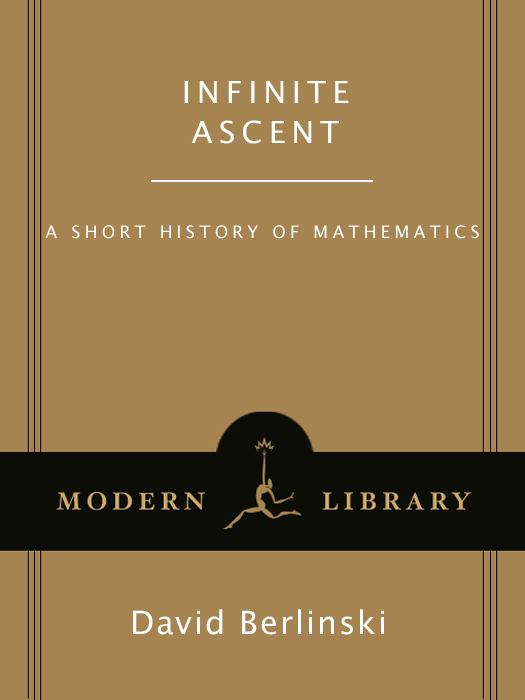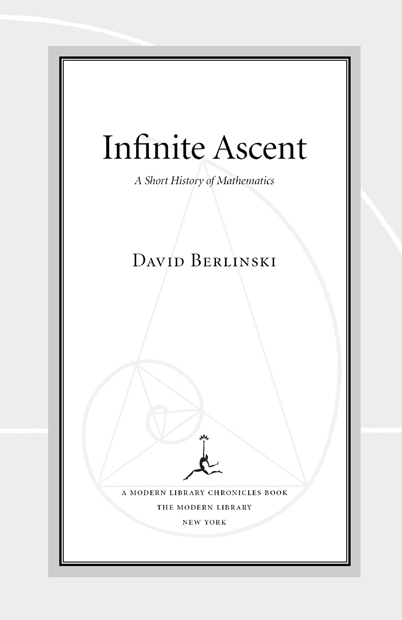A LSO BY D AVID B ERLINSKI
Nonfiction
The Secrets of the Vaulted Sky
Newtons Gift
The Advent of the Algorithm
A Tour of the Calculus
Black Mischief
On Systems Analysis
Fiction
The Body Shop
Less Than Meets the Eye
A Clean Sweep

2008 Modern Library Paperback Edition
Copyright 2005 by David Berlinski
All rights reserved.
Published in the United States by Modern Library, an imprint of The Random House Publishing Group, a division of Random House, Inc., New York.
M ODERN L IBRARY and the T ORCHBEARER Design are registered trademarks of Random House, Inc.
Originally published in hardcover in the United States by Modern Library, an imprint of The Random House Publishing Group, a division of Random House, Inc., in 2005.
LIBRARY OF CONGRESS CATALOGING-INPUBLICATION DATA
Berlinski, David.
Infinite ascent: a short history of mathematics/David Berlinski. p. cm. (Modern Library chronicles).
eISBN: 978-0-307-77817-8
1. MathematicsHistoryPopular works. 2. MathematicsPhilosophyHistoryPopular works. 3. MathematiciansHistoryPopular works.
I. Title. II. Series.
QA21.B54 2005
510.9dc22 2005041519
www.modernlibrary.com
v3.1
F OR S USAN G INSBURG
The number of pages in this book is no more or less
than infinite. None is the first page, none is the last.
JORGE L UIS B ORGES ,
The Book of Sand
CONTENTS

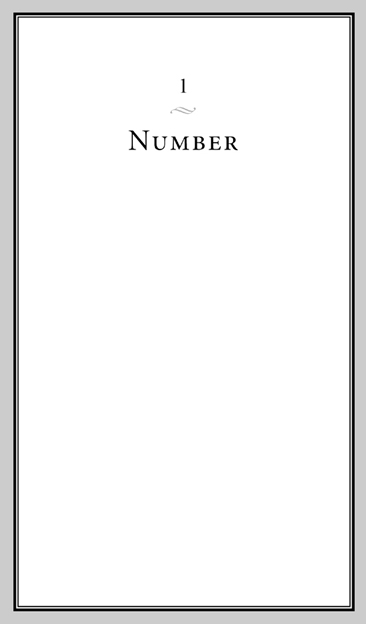
T HE HISTORY OF MATHEMATICS begins in 532 BC, the date marking the birth of the Greek mathematician Pythagoras. Having fled the island of Samos in order to escape the tyranny of Polycrates, Pythagoras traveled to Egypt, where, like so many impressionable young Greek men, he learned number and measure from Egyptians [and] was astonished at the wisdom of the priests. Thereafter, he settled in southern Italy; he began teaching and quickly attracted disciples. Very little is known directly of his life, except that his contemporaries considered him admirable. Nothing from his own hand remains: He has been preserved against the worm of time by the amber of various literary artifacts. Admission to the Pythagorean sect was evidently based on mathematical ability. Secrecy was enforced and dietary restrictions against beans maintained. New members were required to keep silent for a number of years, a policy that even today many teachers will find admirable, and they were expected during this time to meditate and reflect. Some members of the Pythagorean sect regarded the external world as a prison, a cave filled with flickering shadows and dull brutish shapes. Let me add to this confused but static scene the heat lightning of superb mathematical intuition.
Until the mid-twentieth century, the thesis that in mathematics as in almost everything else, the Greeks were there at first light, did not require an elaborate defense. With their forearms draped in friendship over any number of toga-clad shoulders, classicists who had spent years mastering infernal Greek declensions naturally assumed that the Greeks were fellows of another college. The history of the Ancient Near East has come into sharper focus over the past century, great scholars poring over cuneiform tablets and recreating the life of ancient empires that had until their work been swallowed up as the impenetrable before. They have found remarkable things, a history before classical history, evidence that men and women have used and loved mathematics in the time before time began. Neolithic ax-marks have even suggested that the origins of mathematics lie impossibly far in the past, and that men living in caves, their hairy torsos covered by vile-smelling furs, chipped the names of the numbers onto their ax handles as bison grease spattered over an open fire. And why not? Like language itself, mathematics is an inheritance of the race.
The burden of those impossibly distant centuries now disappears. It is roughly six centuries before the birth of Christ. The Greeks are just about to elbow their way into all the corridors of culture. They give every indication of knowing everything and having known it all along. Yet the Babylonians already possessed a remarkably sophisticated body of mathematical knowledge. They were matchless observational astronomers, and they had brought a number of celestial phenomena under the control of precise mathematical techniques. They were immensely clever. I found a stone, but did not weigh it, one scribe wrote. I then weighed out six times its weight, added two gin, and then added one third of one seventh, multiplied by twenty-four. I weighed it. [The result came to] one ma-na. What, the scribe now asks his oil-haired students, was the original weight of the stone? Mathematicians are apt to see an all-too-familiar face peeping through the problems of a Babylonian scribetheir face, of course, ubiquitous and always the same.
But those classicists sipping sherry in the common room of time had been right all along. The Greeks were there at first light.
The natural numbers 1, 2, 3, begin at one and they go on forever, the mathematicians dainty dots signifying an endless progression. As soon as anyone attempts to cap the natural numbers, anyone can find a way to cap the cap, say by adding one to the last natural number capped. If the numbers are infinite, they are also wonderfully various. When the great Indian prodigy Srinivasa Ramanujan lay dying in a London hospital, the cold English winters eating his lungs away now ending his life, his friend, the mathematician G. H. Hardy, paid him a visit. Paralyzed by his own reticence, Hardy could think only to blurt out the number of the taxi that had brought him to the hospital1729, as it happens.
I dont suppose it is a very interesting number, he added.
Oh, no, Hardy, Ramanujan replied at once, it is the smallest number expressible as the sum of two cubes in two different ways.
And so it is: 1729 = 13 + 123 = 93 + 103. No smaller number has this property. The story has become famous. No one quite knows what it means, but every mathematician understands why it is told.
Like Ramanujan, the Pythagoreans were taken with the inexhaustible variety of the natural numbers, their personalities. They were fascinated by 1, 3, 6, and 10, because these numbers could be expressed geometrically as triangles composed of dots. They quite understood the importance of numbers that are divisible only by themselves and 1the prime numbers such as 2, 3, 5, 7, and 11; and they may well have understood that the prime numbers are fundamental, lying like dark rubies amid the pale panoply of the ordinary numbers. They discovered that certain numbers such as 6, 28, and 496 could be expressed as the sum of their divisors. They lived in cavesI mean such is the legendand squatting there, a pile of smooth pebbles in their laps, they saw that there are square numbers as well as triangular numbers, and amicable relationships between numbers, as when each of two numbers is the sum of the others divisors, or when the sum of two consecutive triangular numbers such as 3 and 6 is a square number, and progressions from one series of numbers to another; and in all this, as the tallow dripped from their candles, they treated the natural numbers as if they were themselves men at play, serious but never solemn, their endless curiosity amounting at times to a form of intellectual rapture and so entirely alien to the beetle-browed scribes and accountants of the Ancient Near East, men forever plodding along the severe utilitarian axis of a commercial culture.




